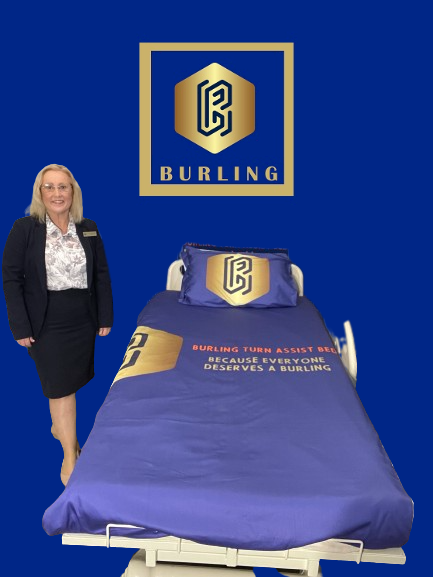Tracy Burling
Not just a Nurse Manager,
but an Innovator and champion for
reducing physicality for carers in Aged Care, Acute Care, Palliative Care & the Disability Sector
"There must be a better way
to achieve the result of
pressure injury prevention"

Tracy Burling is currently a Regional Operations Manager for BaptistCare NSW & ACT, Australia. She brings to the role 30 years of nurse management experience and is degreed in both nursing & business management. Previously a Residential Manager in a large residential aged care facility, Tracy worked alongside care staff on the night shift to understand the needs of the business overnight. During these shifts, she was involved in turning residents using a slide sheet. Tracy considered this to be an outdated practice and concluded there must be a better way to achieve the same result of pressure injury prevention. There had to be a way to perform the same function without the discomfort & disruption to the resident and the injury to the staff we were currently seeing.
SUMMARY OF 12 WEEKS COMPREHENSIVE TRIAL – 22nd March, 2023
Sixteen (16) residents have been cared for on Twelve (12) Burling Turn Assist Beds at
BAPTISTCARE NSW/ACT since December 2022. Eight (8) residents at Kularoo and eight (8) residents at Bethshan. The increase from twelve (12) to sixteen (16) residents has presented due to palliating
residents passing away and the beds being reallocated. Of the sixteen (16) residents, there were three (3) stage 1 pressure injuries recorded during the above mentioned trial period. However, they were NOT aligned to the bed’s performance.
1) One (1) resident experienced a heel blister of unknown origin. It was determined
that depending on the amount of bedding on residents feet the feet may be
prevented from turning with the movement of the bed. The solution is simple. Staff
to either place a pillow under the calves of the resident or physically reposition the
feet under the bedding when the resident is being turned on the bed.
2) Two (2) residents incurred a sacral pressure injury. Both residents with a sacral
pressure injury were from Bethshan. This was because the residents were not
being turned every 2 hours as required. The Bethshan Nurse Call system was able
to identify the times staff enter a resident room. It was identified that intervals of six
hours for staff attendance within resident rooms had occurred. The Residential
Manager and Care Team Manager actively addressed this with relevant team members.
Once the 2 hourly turn was revisited the sacral pressure injury on both
residents resolved and no further injuries have occurred with these two residents. They were NOT
aligned to the bed’s performance.
RESULTS FROM DATA COLLECTION DURING TRIAL PERIOD
1) (81%) 13 residents did NOT receive pressure injuries.
2) 3 residents recorded stage 1 pressure injuries, however the injuries were
resolved quickly and (2) of them were due to staff not attending to residents as
required and (1) was due to the amount of bedding over the feet. They were NOT
aligned to the bed’s performance.
3) (100%) 16 residents did NOT receive skin tears.
4) (100%) 16 residents recorded noticeable improvement in quality of sleep.
Improved quality of life can be associated with improved quality of sleep but was
not measured in this trial.
5) Staff feedback regarding ease of task is also noted.
6) No manual handling injuries were recorded while using the bed.
7) No consumables to dress pressure injuries through use of the bed or skin tears were required.
8) No staff time to dress pressure injuries or skin tears through us of the bed were required.
9) Staff time required to turn each resident in bed was reduced from (16 minutes) 8
minutes 2 x staff member using a slide sheet to (1 minute) 1 x staff member using
The Burling Turn Assist Bed, however this was not recorded during this trial.
CONCLUSION
The trial of The Burling Turn Assist Bed has met all claims and therefore is considered successful. It was found to dramatically reduce pressure injuries on residents, eliminate manual handling
injuries and skin tears due to repositioning residents in bed. Furthermore, if this bed
had been used for every resident that required one, staffing requirements could be
reallocated, medical consumables and time to dress wounds could be eliminated.
Putting the data into a dollar amount, each bed could save a provider in excess of $33,000 over
the 10-year life of the bed when compared to current bed being used and current
pressure injury prevention using slide sheets and air mattresses.
I now give you
The Burling Turn Assist Bed
Because Everyone
Deserves A Burling
Book an online presentation
or
On site demonstration
TODAY
Understand how The Burling Turn Assist Bed can reduce costs and manual handling
injuries in your business


